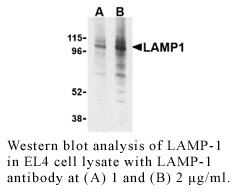Anti-Human Lysosome Associated Membrane Protein-1 (LAMP-1)
Data
- -
- -
Antibody DetailsProduct DetailsReactive Species Human Host Species Rabbit Immunogen PN:L170 Product Concentration 0.5 mg/ml Formulation This polyclonal antibody is formulated in phosphate buffered saline (PBS) pH 7.4 containing 0.02% sodium azide as a preservative. Storage and Handling This polyclonal antibody is stable for at least one week when stored at 2-8°C. For long term storage, aliquot in working volumes without diluting and store at –20°C in a manual defrost freezer. Avoid Repeated Freeze Thaw Cycles. Country of Origin USA Shipping Next Day Ambient RRIDAB_2831134 Each investigator should determine their own optimal working dilution for specific applications. See directions on lot specific datasheets, as information may periodically change. DescriptionDescriptionSpecificity Rabbit Anti-Human Lysosome Associated Membrane Protein 1 (Lamp-1) recognizes mouse, rat and human Lamp-1. This polyclonal antibody was purified using affinity chromatography. Background Autophagy, the process of bulk degradation of cellular proteins through an autophagosomic-lysosomal pathway is important for normal growth control and may be defective in tumor cells. It is involved in the preservation of cellular nutrients under starvation conditions as well as the normal turnover of cytosolic components1,2 and is negatively regulated by TOR (Target of rapamycin).3 A protein recently found to be involved in autophagy, LAMP-2, is a highly glycosylated protein associated with the lysosome.4 LAMP-1 shares much homology to LAMP-2 and is thought to have overlapping functions. Mice lacking LAMP-1 had very minor defects compared to those deficient in LAMP-2 expression. However, the loss of both proteins resulted in embryonic lethality, suggesting that each protein possesses some unique and necessary functions. PubMed References & Citations1. Gozuacik, D. and Kimchi, A. (2004) Oncogene. 23:2891-906. 2. Kisen, GO. et al. (1993) Carcinogenesis. 14(12):2501-5. 3. Kamada, Y. et al. (2000) J Cell Biol. 150(6):1507-13. 4. August, JT. et al. (1985) J Cell Biol. 101(1):85-95. Technical ProtocolsCertificate of Analysis |
Related Products
- -
- -




